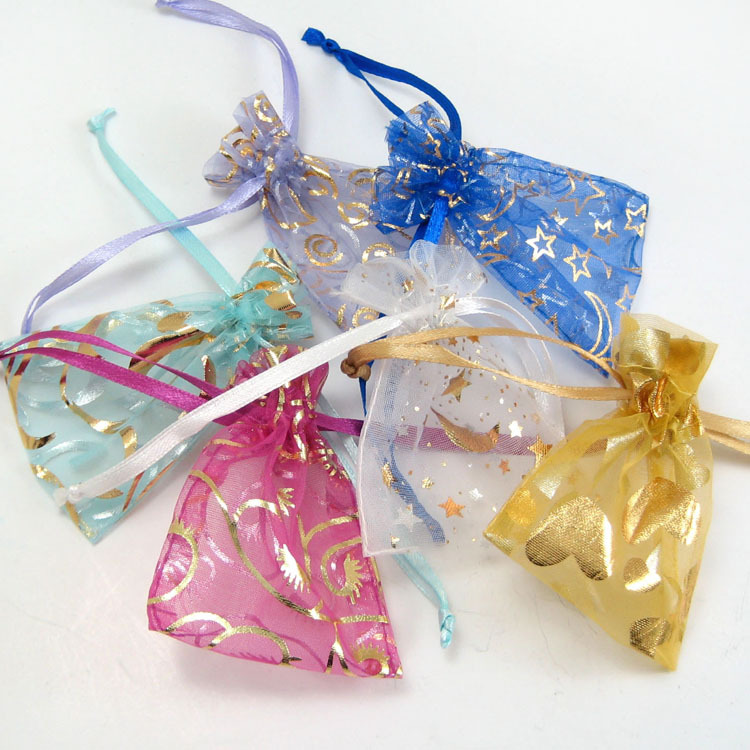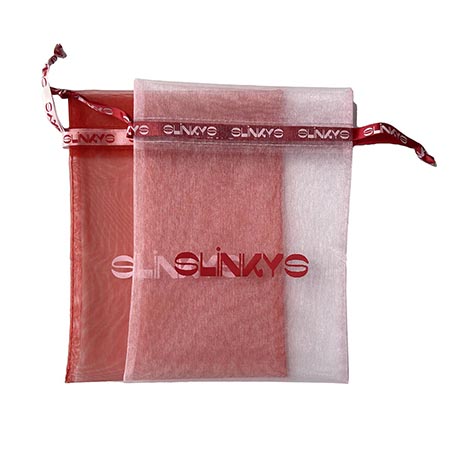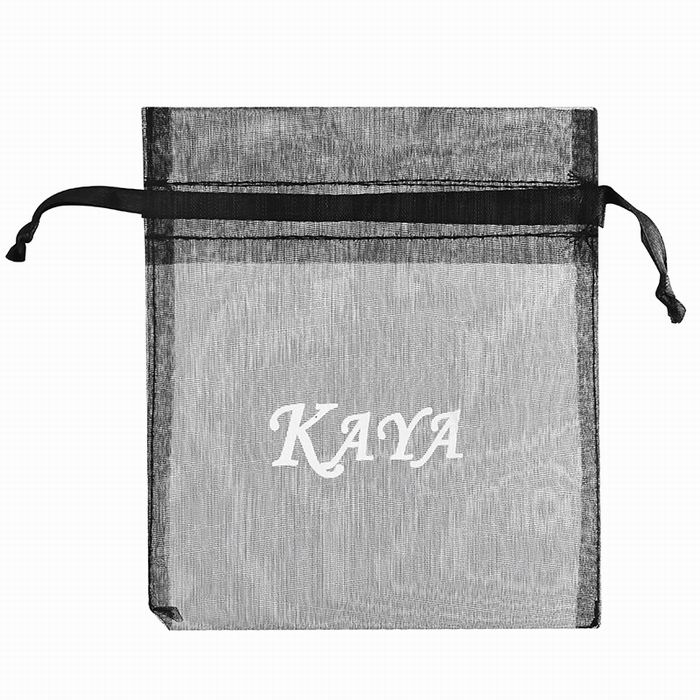Organza Drawstring Bags: The Green Trump Card in Sustainable Packaging
As global demand for eco-friendly packaging surges, Organza drawstring bags are quietly emerging as a "green trump card" for brands looking to replace traditional packaging. With their lightweight nature, aesthetic appeal, and reusability, these bags are gaining traction across industries—from beauty brands to cross-border e-commerce sellers. More and more businesses are realizing that this delicate sheer fabric does more than just hold products; it silently communicates brand values.
Material Composition and Key Features of Organza
Material Composition
Organza is a transparent, stiff fabric traditionally made from polyester (polyethylene terephthalate) or silk. The modern eco-friendly version incorporates bio-based materials, such as corn starch-based fibers (e.g., 30% plant-based content + 70% recycled polyester), ensuring both a lightweight feel and sustainability.
Key Features
- Physical Properties
- Lightweight and sheer with a natural sheen, providing a clear display of the enclosed product.
- Crisp texture that maintains a structured shape without collapsing.
- Breathable and moisture-resistant, making it ideal for packaging food, cosmetics, and more.
- Eco-Friendly Upgrades
- Bio-based versions achieve a natural decomposition rate of ≥90% within 180 days.
- Low-temperature dyeing technology reduces water consumption by 40%.
- Durable Design
- Tear resistance is 1.8 times higher than regular organza, supporting up to 2kg of weight.
- Anti-static treatment prevents dust accumulation, extending usability.
- Customization Advantages
- Compatible with foil stamping, silk-screen printing, and embroidery.
- Can be enhanced with waterproof coatings or antibacterial functional layers.
Organza Drawstring Bags: A Practical and Sustainable Packaging Choice
As a manufacturer specializing in drawstring bags, we have observed a growing shift towards Organza drawstring bags as a replacement for traditional packaging. These lightweight, translucent bags offer both visual appeal and a powerful way for brands to convey their commitment to sustainability. Here are five key insights into Organza bags:
1. Eco-Friendly & Durable Materials
While Organza bags may look similar at first glance, their material composition varies significantly:
- Plant-Based Plastic Alternative: Our bags incorporate 30% corn starch-based polyester fibers, reducing carbon emissions by nearly 50% compared to standard polyester.
- Tear-Resistant Weaving: A specialized weaving process doubles load-bearing capacity, ensuring that items like mobile phones and cosmetics stay protected.
- Reusable Design: Washable and reusable, significantly reducing single-use packaging waste.
2. A Mobile Branding Tool
Organza bags serve as portable brand ambassadors:
- Long-Lasting Custom Prints: Eco-friendly water-based inks ensure vibrant, non-fading designs that withstand 50 wash cycles.
- Light-Responsive Branding: Logos appear prominently in natural daylight, while embedded reflective fibers provide a subtle glow at night.
- Interactive QR Codes: A waterproof fabric label with a QR code stitched inside the drawstring allows customers to access discounts or product stories with a simple scan.
3. A Versatile Companion Across Industries
Beyond gifting and retail packaging, Organza bags prove useful in multiple scenarios:
- Beauty Industry: Ideal for packaging makeup brushes and sample products, offering convenience for travel.
- Jewelry & Accessories: The sheer fabric subtly showcases the enclosed pieces, enhancing the unboxing experience.
- Weddings & Events: Used for packaging wedding favors, invitations, and keepsakes that can later be repurposed as jewelry pouches.
- Food Samples: FDA-compliant versions are suitable for storing tea bags, coffee beans, and other gourmet samples.
8 Innovative Industry Applications
1. Beauty & Personal Care
- A Korean skincare brand increased social media engagement by 45% after introducing gradient-colored Organza bags for face mask packaging.
- Infused fragrance-releasing sheets inside the bags create a signature scent upon unboxing.
2. Electronics
- A headphone brand replaced plastic cases with scratch-resistant Organza bags, reducing packaging costs by 60%.
- Conductive fiber layers were integrated for electrostatic protection.
3. Pet Supplies
- Washable, antibacterial Organza bags used for pet treat packaging increased repeat purchases by 32%.
- Customized with paw-print designs and pet-safe certification, making them an Instagram sensation.
4. Luxury Accessories
- Silk-blended Organza pouches served as dust covers for watches, increasing average order value by $30.
- Metallic embroidery on the logo retained a premium brand aesthetic.
Industry Trends & Market Insights
1. Global Market Outlook
- The eco-friendly packaging market reached $305.9 billion in 2023, growing at 6.7% annually (Source: Smithers).
- 73% of Western consumers are willing to pay a 5% premium for sustainable packaging (Nielsen).
2. Platform Policy Shifts
- Amazon’s "Climate Pledge Friendly" products gain 27% more visibility.
- AliExpress now factors sustainability into search ranking algorithms.
3. Design Trends
- Popular Styles: Marble patterns, metallic finishes, and gradient tie-dye.
- Emerging Demands: Traceable QR codes, Braille labeling, and multi-size packaging bundles.
Client Success Stories
1. Singaporean Tea Brand
Switched to compostable Organza bags paired with herb-seed-infused hangtags—leading to a 41% customer participation rate in planting the seeds, driving ongoing user-generated content (UGC).
2. Shenzhen Cross-Border E-Commerce Seller
Replaced traditional gift boxes with transparent Organza pouches, reducing package weight by 53g per unit and saving $120,000 annually in international shipping costs.
3. New York Jewelry Studio
Developed a magnetic closure Organza pouch, helping reduce return rates from 8% to 2.3% for high-value jewelry pieces priced over $300.
Conclusion
As Gen Z embraces sustainability as a core value, Organza bags are evolving from disposable packaging to reusable branding tools that reinforce eco-conscious messaging. Through material innovation, storytelling integration, and smart manufacturing, we are co-creating a new paradigm of responsible and aesthetically compelling packaging—a silent yet powerful dialogue between brands and consumers, shaping the future of packaging.





 We like to do design according to all the customers' requirements, or offer them our new designs. With strong OEM/ODM capabilities, we can fill your sourcing demands.
We like to do design according to all the customers' requirements, or offer them our new designs. With strong OEM/ODM capabilities, we can fill your sourcing demands.